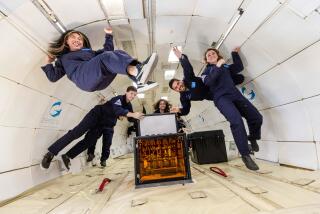At Singularity University, technology is seen as savior
- Share via
MOUNTAIN VIEW, CALIF. — Chatter about ensuing plans permeates any graduation, though it’s not common for the talk to surround which class projects will receive venture capital funding.
This was a hot topic at the first commencement at Singularity University, a school that is backed by Google, operates on NASA’s Silicon Valley campus and gets its name from co-founder Ray Kurzweil’s favorite term for our technologically enhanced future.
Founded last year with the idea that rapidly evolving technologies can be harnessed to solve problems like poverty and climate change, Singularity University does not offer a traditional degree -- though it is working to get some universities to accept students’ coursework for credits.
More than a graduate school, it resembles an incubator for technological ideas that, at the end of a nine-week program, may turn into actual companies with a humanitarian edge.
Starting in June, students spent three weeks attending lectures by faculty members and visiting luminaries such as Vint Cerf -- one of the founding fathers of the Internet -- to get a basic grounding in fields ranging from networks and computing systems to artificial intelligence and robotics. After that, they chose one of four subjects to study more closely for three weeks. For the privilege, the 40 members of the initial class paid $25,000 apiece.
Singularity is working bring the cost down, by starting monthly sessions for executives in November. Those will fund scholarships for the summer program, said Peter H. Diamandis, Singularity co-founder and CEO of the X Prize Foundation. The school also has been bolstered by $2 million in seed donations, $250,000 of which came from Google.
Despite the cost, there were 1,200 applicants. Executive director Salim Ismail said the next session -- which is slated for mid-June 2010 -- will include 100 or 120 students.
The premise for the school is that change is occurring exponentially from the frenetic pace of technology and globalization.
In the final weeks of their studies, students split into four groups and created projects whose only requirements were that they needed to focus on one of the world’s great challenges and have the potential to improve the lives of a billion people over a decade.
Wait, a billion people? Really?
The goal, as some Singularity faculty admit, sounds lofty. But with classic Silicon Valley optimism, the faculty, leaders and students seem confident that work done at Singularity U. will change the world.
“Ultimately, breakthroughs come from young, unconstrained thinkers who have a bold vision of the future and don’t know that they can’t make it happen,” Diamandis said, adding that many of the engineers who built NASA’s Apollo space program in the 1960s were in their 20s.
There were no spaceship models on display during a presentation of the projects Thursday afternoon. One team, called Acasa, proposed the use of rapid prototyping machines to essentially “print” affordable housing. Another team, Gettaround, showed an iPhone application and corresponding in-car technology that people can use to rent out their cars to others when not using them -- without needing to hand over their keys.
The groups displayed their work to a room full of faculty, staff and potential investors, explaining how and when their projects could play out in the real world.
At a reception afterward, attendees piled plates with fragrant Indian food while venture capitalists mingled with some students.
Margo Liptsin, 23, a member of Acasa who is about to begin pursuing a Ph.D. in the history of science at Harvard, said her group arrived at its idea for the automated construction of affordable homes after toying with “three-dimensional printing,” a process that uses a machine called a rapid prototyper to “print” an object, often out of plastic.
Acasa explored how this technology could be used to help people, and figured housing was the most relevant and tangible answer, Liptsin said. An architect in her group suggested the team get in touch with University of Southern California professor Behrokh Khoshnevis, who had developed a rapid prototyping technology that can be used to make walls. Khoshnevis agreed to work with the students as their chief technology officer.
Over the next few weeks, Acasa plans to meet with venture capitalists. The company is seeking $10 million in initial funding, and it hopes to build a prototype house within eight months of getting financing. Acasa wants to build its first houses in Mexico and branch out from there.






